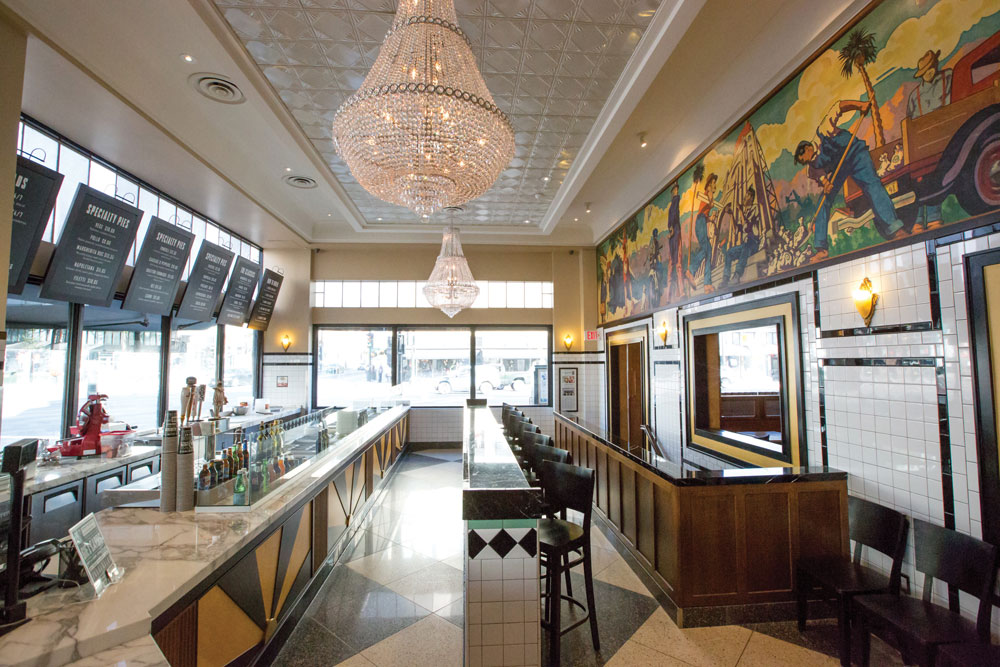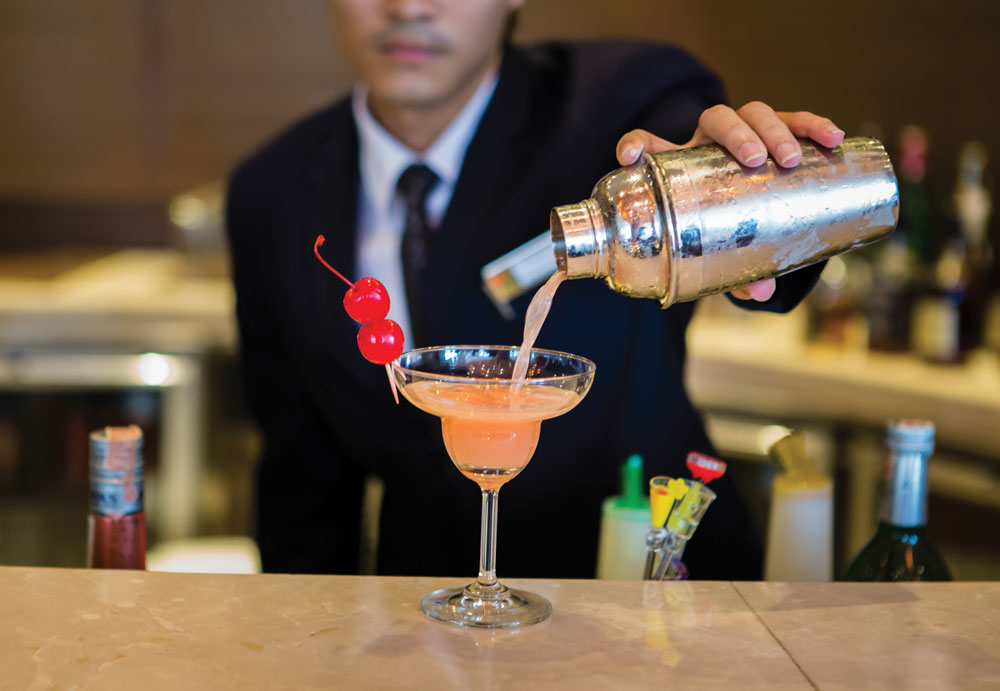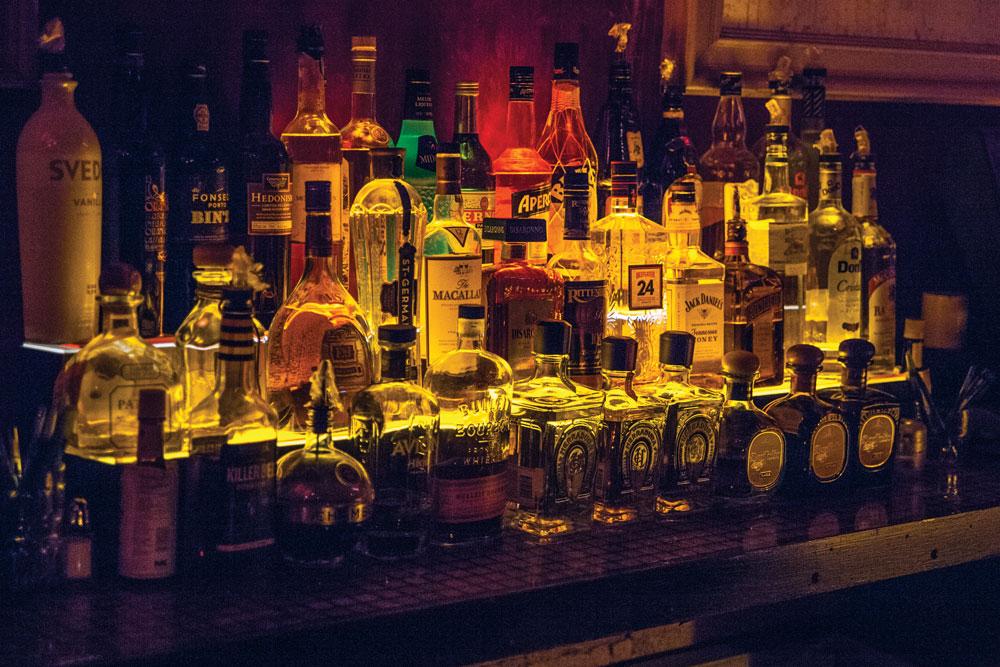Delicious pizza may draw customers to your restaurant, but once they’ve cleaned their plates and wiped their mouths, they typically head straight for the door. Adding a bar—especially a full-service one with beer taps, Bacardi and Black and Tans—means they won’t be in such a hurry to leave. And considering the profitability of beverage sales, the longer they linger, the more money you’ll make.
Before you decide to add a bar to your operation, you’ll need to consider some critical points: What drinks will you serve—wine and beer only, or cocktails as well? How will the bar mesh with and reinforce your brand? How much volume do you anticipate? How much space can you allocate for the bar itself, as well as for storage and equipment? All of these decisions will help you design the best bar for your operation. For those at the beginning of the process, our experts share some of the must-haves and best practices for running a successful bar. Belly up!
The Glass Ceiling
Selecting the right glassware for your operation depends on the types of beverages you’ll serve. If you sell high-end craft brews, you might want to consider specialty glassware; if you do a booming summer business, you might need glasses for tropical frozen drinks. “It all depends on your drink menu, which also requires you to look at volume and space—how many customers do you think you’ll serve?” says Nico Hendi, principal at Studio Kontekso, a restaurant-industry design group in Costa Mesa, California. “This will also help determine the amount of glassware you’ll need, as well as what you need for liquor inventory and storage.”
Los Angeles-based 800 Degrees Neapolitan Pizzeria (800degreespizza.com), which has seven locations nationwide, uses custom-branded paper cups for its self-serve soda machines, while locations with beer and wine stock pint glasses and stemless wine glasses, says founder Anthony Carron. But its full-service bar in downtown Los Angeles also stocks cocktail basics, including martini, highball and rocks glasses.
You’ll also need to consider washing requirements for the glassware. At 800 Degrees, for example, the local health department requires a three-compartment sink at the bartender’s station, with a 12” drain board on each side, taking up about 4’ to 6’ of space. A separate dishwasher is located in the back of the house. You can also keep an automated glass washer under the bar if you have space (typically, 24”); during slower periods, bartenders and barbacks can pitch in to wash glassware. As far as optimal placement of the washing area, Hendi recommends keeping it to the side of the bar that’s least busy. If you have two bartenders, he says, place it in the middle, where both can have easy access.
“The tricky thing in most bars is having pick-up and drop-off areas close to each other,” adds Noah Ellis, co-founder of Vice Food & Beverage in Los Angeles, which designed the full bar at 800 Degrees’ downtown Los Angeles location. “If you have to walk glasses from one area to another, make sure it’s the used glasses and structure the bar so the service well is as close to the pickup area as possible.”
 |
|
At 800 Degrees Neapolitan Pizzeria in Los Angeles, proper layout is key for maximizing bar staff productivity and improving the customer experience 800 degrees neapolitan pizza |
On Ice
There are many ice shapes and sizes, but 800 Degrees utilizes a standard ice cube machine, with pieces that are flat on one side and slightly rounded on the other. “This shape is really efficient for ice machines to make,” Ellis explains. “It’s solid, not hollow, and the machines can produce a lot without a big footprint.” You can also choose a machine for 1” cubes with no divots, but they take up more space and tend to be more costly. Standard machines fit in a 24” space, but machines that make 1” to 1¼” cubes take up at least 40” of space, Ellis notes. “Determine how important your specialty cocktails will be when you’re making those decisions,” he advises.
Because ice machines are bulky (about 5’ wide) and less visually appealing, they’re best kept in the back of house, Hendi adds. They also generate significant heat, which will overwork your HVAC system and make patrons uncomfortable if placed in the bar area.
The Hard Stuff
When designing a full-service bar, consider how you’ll arrange your inventory. You might choose to display high-end liquors or champagnes, or particular types of liquor. For example, at the 20’-long bar in 800 Degrees, the back bar is mirrored and framed by glass shelves, which display classic Italian aperitifs and digestifs, such as Campari and vermouth.
Your most-used bottles should be placed in the speed rails attached to the jockey box (the ice bin), alongside your ice and mixers, while top-shelf spirits are often displayed behind the bar, according to Hendi. “On the very top shelf, we often put dummy bottles, because bartenders can’t reach them,” he says. “You can store inventory at the bar, but the bulk of inventory will be stored in a liquor room in the back. Stock the bar with what you’ll need for the night, then replenish at the end of the night for the following day.”
At 800 Degrees, a couple of shelves also display high-quality, well-known spirits—including big-name brands that are familiar to customers. Meanwhile, stocking lesser-known brands provides value for guests and allows Carron to offer happy hour specials while maintaining profits. “Well and specialty cocktail items stay in rails off the ice bins, but every product is displayed,” says Ellis. “How many brands you carry depends on your location—there is no magic number, but I would plan for 70 to 100 products, including different cordials, well brands, big brands, bitters, etc.”
Ellis recommends carrying one major gin brand (such as Tanqueray); two whiskeys (Jack Daniels is popular); a bourbon (Maker’s Mark or Jim Beam); two single-malt scotches from different regions (Macallan and Glenmorangie); a blended scotch (Johnny Walker); a couple of high-end vodkas (Belvedere, Grey Goose or Ketel One); and tequila (Patrón). “We offset those premium brands with lesser-known brands so that guests can choose how much they want to spend,” Ellis explains. “If you have local brands that are well-known or gaining traction, it’s a good practice to bring them in—they can send business your way.”
When serving liquor, you should measure pours to maintain consistency and minimize waste. While there are now high-tech systems that measure pours remotely, our experts believe old-fashioned training is key. “Standard modern jiggers are cheap, work well, and never break,” Ellis says. “If you know you’ll do a ton of volume, you can do an electric or magnetic pour controller, but they get really expensive—and you have to maintain those systems. I prefer traditional jiggers from cost and consistency standpoints.”
Hendi recalls one client that paid $30,000 for a wireless pour system, but it never quite worked properly. “High-volume pub-type environments ultimately lose money on pour-control systems because they slow down the bartender, versus a free pour,” he explains. “Monitoring bar staff and proper training are better investments—but systems that control the pour can work well for a smaller operation.” Regardless of the control methods you choose, evaluate your potential cost savings beforehand and put systems in place to monitor liquor inventory.
For cocktails, Ellis says, you’ll need additional equipment: a jockey box, which attaches to a bottle rail; ice scoops (made from plastic, aluminum or stainless steel); shakers (metal or glass); stirring spoons; boards; paring knives; and/or a blender for frozen drinks. “Most high- volume places don’t want to deal with blended drinks because they’re so time-consuming for the bartender, but they can work in sit-down restaurants,” Hendi says. “You shouldn’t need more than one blender station unless you’re doing margarita nights!”
 |
|
Specialty glassware can be a sound investment for bars that offer high-end cocktails. |
Soft Touches
Even if you offer only beer and wine, analyze your customer base and concept to make the most of your bar program. For example, six taps in 800 Degrees always feature Peroni (keeping with its Italian theme), one light domestic and four craft options; eight to 10 bottled beers rotate and skew toward craft brews. But a casual pizzeria should stock more big-brand domestics. “You want to have a complementary price point from your beverage to your food,” Ellis suggests. “Stay in line with your local area and capitalize on local brands. It’s nice to present new things to customers, but nobody likes being told what to drink.”
Under-the-bar kegs work well for smaller locations, while bigger venues store kegs remotely, with lines running to the taps. “A 5,000-square-foot restaurant with 10 beers on tap wouldn’t use under-the-counter draft systems,” Hendi notes. “But a couple of beers on tap can be handled under the counter—and they’re cheaper as well, because you need a walk-in cooler for a remote system.”
Under-the-counter keg storage is more manageable; it’s easier to clean the lines, and there’s less waste, Ellis adds. He recommends remote setups only for huge volumes—if beer will be 20% to 25% of sales, for example. Also, set aside proper storage space for inventory. “You need about 48 linear inches, or 4 linear feet, of storage space per well, though it depends on if you have a walk-in or other storage,” Ellis says. “You’ll use a couple of shelves for glassware, mixers, beers and bottled wine.”
Meanwhile, you can typically obtain soda guns from the soda company you partner with, which will pay for the gun, lines and installation, Hendi notes. “You will need a bag-in-box room for your syrups,” he adds. “If back-of-house space is an issue, half-size CO2s can be placed under the bar, but the tanks will need to be changed more often.”
Ellis also recommends high-quality mixers for cocktails, including juices (grapefruit, orange, lemon, cranberry, pineapple, and/or tomato for Bloody Marys) and sodas (tonic, club, cola, diet cola, and lemon-lime). As with any new menu items, keep an eye on what sells best—and what your customers could do without.
| The Bar Manager’s Cheat Sheet |
| Noah Ellis, co-founder of Vice Food & Beverage in Los Angeles, suggests the following setup must-haves for every bar, per well/jockey box:
1 lime juicer |















